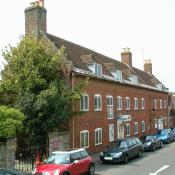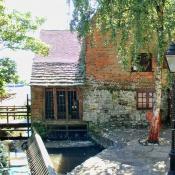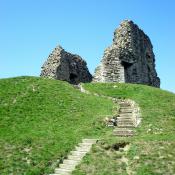Reputedly the longest parish church in England, the current building dates back to 1094. This grand church is built on the site of a 7th century Saxon Priory
Christchurch Priory, consisting of 24 secular canons, was recorded in the Domesday book and Christchurch Priory Church dates back to the eleventh century. It was probably built on the site of a much earlier church founded by King Cyneglis of Wessex, who was baptised in 635.
At that time Christchurch was known as Thuinam, which later evolved into Twynham. Located near an excellent harbour and at the confluence of the Rivers Stour and Avon, then navigable as far inland as Salisbury, Thuinam was an important settlement. It was included in King Alfred's list of fortified boroughs that dates back to the ninth century.
Work began on the present church in 1094 when Ranulf Flambard (Rufus), Chief Minister to William II and Dean of Twynham, began building on nearby St Catherine's Hill. Legend has it that all the building materials were mysteriously transported to the present location in the middle of the night. Another legend explains how Twynham came to be Christchurch. Apparently a crucial beam was found to have been cut too short. All the carpenters except for one, a mysterious man who worked and ate alone, went home that night despondent and embarassed. Their mistake was a costly one. The wood they had used for the beam was expensive and hard to source. When they returned in the morning, however, they found the beam in place and fitting snugly. The mysterious carpenter, meanwhile, vanished, never to be seen again. At a loss for an explanation the men decided the mysterious carpenter must have been Jesus Christ and Twynham became Christchurch.
Work continued after Ranulf's death. By the middle of the twelfth century there was a basic Norman church with a nave, central aisle and quire (monk's chapel). In 1150 Baldwin de Redvers, Earl of Devon and Lord of the Manor of Christchurch replaced the secular priory with an Augustinian one. For the next one hundred and fifty years Christchurch Priory continued under the patronage of the de Redvers family, until in 1293 the last in the line, Isabella de Fortibus, Countess of Devon, sold her eastern estates to the crown for four thousand pounds. Christchurch became a royal manor. In 1330 Edward III granted the manor to Baron William de Monatacute, who became the first Earl of Salisbury.
In the meantime work on the church continued. The Montacute chapels were added, as was a lady chapel and pendant vaulting thought to be the first of its kind in England. The tower was rebuilt in the latter half of the fifteenth century. By about 1530 the church looked much as it does today. The monastic buildings were pulled down by Henry VIII in 1539, but the church was saved following a plea from the townspeople. It has been used as a parish church ever since.
In 1999 a window celebrating the nine hundredth anniversary of Christchurch Priory was installed. It shows a starry night dominated by the cross, which is surrounded by a pattern of circles supposed to symbolise eternity and perfection. Measuring three hundred and eleven feet, four inches long Christchurch Priory is officially the longest parish church in England.




